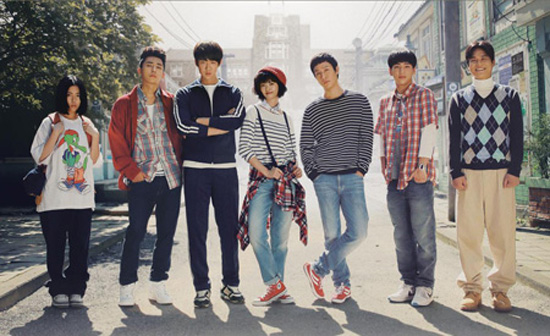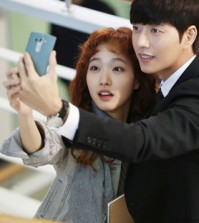- California Assembly OKs highest minimum wage in nation
- S. Korea unveils first graphic cigarette warnings
- US joins with South Korea, Japan in bid to deter North Korea
- LPGA golfer Chun In-gee finally back in action
- S. Korea won’t be top seed in final World Cup qualification round
- US men’s soccer misses 2nd straight Olympics
- US back on track in qualifying with 4-0 win over Guatemala
- High-intensity workout injuries spawn cottage industry
- CDC expands range of Zika mosquitoes into parts of Northeast
- Who knew? ‘The Walking Dead’ is helping families connect
Going retro
‘Reply 1994′ traces back Korea popular culture
By Chung Ah-young
If you grew up listening to Seo Taiji & Boys, watching the university basketball league and using a beeper, you must be crazy about the drama series “Reply 1994.”
Airing on tvN, a cable network run by CJ E&M, the retro drama is hitting the highest viewer rating among cable channels, even outperforming other television series aired on terrestrial broadcasters.
Starring Go Ara and Jung Woo, the inaugural episode of the series was launched on Oct. 18 with much anticipation as a prequel to the successful “Reply 1997,” which was broadcast last year. The first episode recorded a 2.6-percent average rating and a month later, its rating has quadrupled to 9.3 percent for the latest episode.
Set in 1994, six university students from various provincial areas live together at a boarding house run by a couple with a daughter named Na-jung (Go Ara), the female lead, in Sinchon, Seoul. The timeline moves back and forth between the past in 1994 and the present in 2013, making the viewers guess who will become Na-jung’s husband among the male characters.
Behind an intriguing storyline are nostalgia-provoking details such as video tapes, beepers and the early extreme fan culture of pop stars and basketball players whose popularity was akin to the current K-pop “idol” stars.
The coming-of-age drama represents the Generation X’s past tastes through their “happy” younger era packed with fond memories. The generation that attended university in the mid-1990s was stuck somewhere between the democratic student movement of the 1980s and individualism or consumerism of the 1990s. And they experienced the economic boom until the Asian financial crisis drove the nation into the decades-long recession in 1997.
The drama is getting popular enough to spur users of Facebook groups, blog posts and YouTube clips to immediately share their recollections of the ’90s. When the show was first aired, 30-40 something was old enough to be nostalgic. But now a wide range of age groups are becoming addicted to the drama.
Back to ’90s music
After the drama’s airing on Fridays and Saturdays, everything from music to the lines between the characters is becoming the talk of the town. Particularly, ’90s music is capturing the hearts of the audience. Indeed, ’90s music in Korea was diverse in genres from dance, rock, R&B and hip-hop to ballads, a prelude to the K-pop boom, critics said.
For example, songs from Seo Taiji & Boys, Deux, Solid and 015B led the Korean music scene in their respective genres at the time. These ’90s musicians are not that active now ― some of them work as producers nurturing young musicians and others release albums once in a while.
Critics said that back then, although the size of the music market was not that big, diverse genres flourished, satisfying different tastes of music fans. The musical nostalgia becomes explosive when combined with the retro images of the drama.
They also point out that a return to the ’90s music is partially due to fatigue triggered by massive digital access to music with a couple of mouse clicks or taps on the screen of mobile phones. Also, those who are in their 30s-40s can hardly find their taste of music in this K-pop dominated market. Critics said that the dearth of diversity in the current music scene attracts these viewers to the retro culture.
“I am really a big fan of the drama because it makes me feel as if I am living in that year. The ’90s songs from the drama provoke the romantic sentiment back then. I am sick of K-pop songs which are usually targeting a teenage audience,” a 37-year-old office worker, identified as Kim, said.
The drama also offers a clue to understand the K-pop evolvement through the diverse musicians who were active in the ’90s which was seen as the golden age of Korean popular music history.
Overseas response
“Reply 1997” formed a huge fan base not only in Korea but also in other countries although the drama was looking back to the Korean retro culture that is not familiar to foreign viewers. It also contains diverse dialects from provincial areas.
After the former season ended, CJ E&M held a “Reply 1997 Cover Contest” through YouTube and Facebook channels. Contestants from all over the world including the U.S., Australia, Hong Kong, China and Brazil competed through recordings of their own version of the duet song by the main characters played by Seo In-gook and Jung Eun-ji.
Eighty-five percent of participants were foreigners which shows how popular the drama was overseas. CJ E&M said that like Psy’s “Gangnam Style,” the spreading of K-pop has had a huge boost through online platforms like YouTube.
Like the success of the previous season, “Reply 1994” is gaining a growing response from Asian hallyu fans particularly in Vietnam. The Vietnamese fans are already responding to the ’94 version as they think that it is a common pleasure to jog memories of the good old days. They operate a fan site on Facebook to share opinions about each episode.
“I like the drama because it’s about the past love and ends beautifully. Also, it is not difficult to understand the fan culture portrayed in the drama as the current K-pop idol groups are generating numerous fan bases all over the world,” Giang River said on the CJ E&M blog.

















Cover letter template
August 12, 2017 at 1:47 AM
More About the Concept of an Afterlife: The only part of you that could in any way survive into an afterlife would have to be an immaterial part of you since when you snuff it, your material remains go nowhere. But any immaterial part of you would have no sensory apparatus so how could you enjoy an afterlife when you couldn’t experience it? On the other hand, if your life is but a computer simulation, then equally so could your afterlife be another simulation. One software program ends (death) and another begins (afterlife).